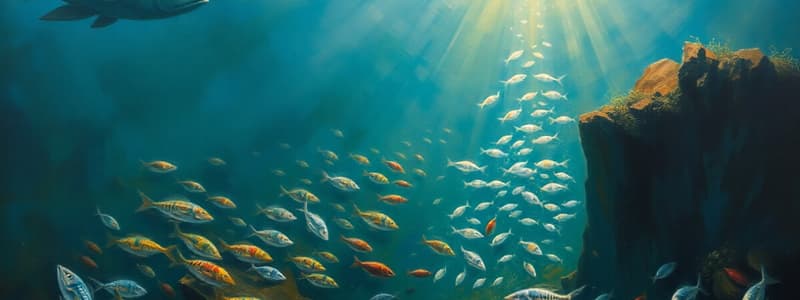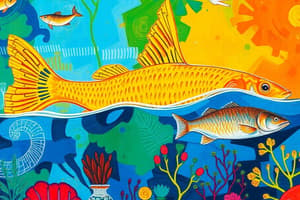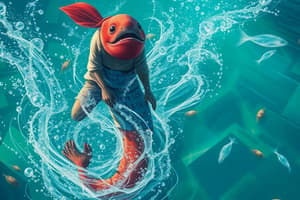Podcast
Questions and Answers
What has caused production from capture fisheries to stagnate?
What has caused production from capture fisheries to stagnate?
- Enhanced fishing technology
- Increased investment in aquaculture
- Decreased demand for fish products
- Overcapacity in fishing fleets (correct)
What is the main consequence of overfishing in marine fisheries?
What is the main consequence of overfishing in marine fisheries?
- Stabilization of fish stock sizes
- Reduction of available fish for harvest (correct)
- Increased biomass of fish populations
- Improvement of marine ecosystems
Which of the following represents the long-run equilibrium of a fishery in the absence of fishing?
Which of the following represents the long-run equilibrium of a fishery in the absence of fishing?
- Stock size at S1 (correct)
- Maximum sustainable economic rent
- Maximum economic profit
- Sustained yield curve
What is characterized by the pair (y1, S1) in the fishery growth model?
What is characterized by the pair (y1, S1) in the fishery growth model?
What is the estimated loss of economic net benefits from marine fisheries in 2012?
What is the estimated loss of economic net benefits from marine fisheries in 2012?
What does maximum sustainable yield correspond to in a fishery's growth model?
What does maximum sustainable yield correspond to in a fishery's growth model?
What is one of the main problems currently faced in marine fisheries?
What is one of the main problems currently faced in marine fisheries?
What happens to the stock if harvest is held constant at y1 and there’s a random increase in the stock?
What happens to the stock if harvest is held constant at y1 and there’s a random increase in the stock?
What is the most efficient level of fishing effort related to sustained yields?
What is the most efficient level of fishing effort related to sustained yields?
What happens when individuals freely enter a fishery under open access conditions?
What happens when individuals freely enter a fishery under open access conditions?
How do Total Allowable Catch (TAC) limits impact resource rent?
How do Total Allowable Catch (TAC) limits impact resource rent?
What is the relationship between fishing effort level E* and sustained yield?
What is the relationship between fishing effort level E* and sustained yield?
What is a primary issue associated with command-and-control policies in fisheries?
What is a primary issue associated with command-and-control policies in fisheries?
Which fishing practice has led to inefficiencies by promoting conservation?
Which fishing practice has led to inefficiencies by promoting conservation?
Which of the following best describes Individual Transferable Quotas (ITQs)?
Which of the following best describes Individual Transferable Quotas (ITQs)?
What typically results from the 'race for fish' scenario in open access fisheries?
What typically results from the 'race for fish' scenario in open access fisheries?
What does the efficient level of fishing effort maximize?
What does the efficient level of fishing effort maximize?
In what way can quotas address issues in fisheries management?
In what way can quotas address issues in fisheries management?
What generally happens to profits in an open access fishery?
What generally happens to profits in an open access fishery?
Why might political rent seeking occur in fisheries management?
Why might political rent seeking occur in fisheries management?
What characterizes a fishery regulated by Individual Transferable Quotas (ITQs)?
What characterizes a fishery regulated by Individual Transferable Quotas (ITQs)?
What impact does increased fishing effort beyond maximum sustainable yield typically have?
What impact does increased fishing effort beyond maximum sustainable yield typically have?
Flashcards
Overfishing
Overfishing
Excessive fishing, depleting fish populations beyond sustainable levels.
Overcapitalization (Fisheries)
Overcapitalization (Fisheries)
Excessive investment in fishing fleets, leading to overfishing.
Open-access fisheries
Open-access fisheries
Fisheries where access to fishing is unrestricted, leading to overfishing.
Maximum Sustainable Yield (MSY)
Maximum Sustainable Yield (MSY)
Signup and view all the flashcards
Biomass Growth Function
Biomass Growth Function
Signup and view all the flashcards
Steady-state Equilibrium
Steady-state Equilibrium
Signup and view all the flashcards
Logistic Model (Fisheries)
Logistic Model (Fisheries)
Signup and view all the flashcards
Sustained Yield Curve
Sustained Yield Curve
Signup and view all the flashcards
Maximum Sustained Yield (MSY)
Maximum Sustained Yield (MSY)
Signup and view all the flashcards
Efficient Fishing Effort
Efficient Fishing Effort
Signup and view all the flashcards
Open Access Equilibrium
Open Access Equilibrium
Signup and view all the flashcards
Total Allowable Catch (TAC)
Total Allowable Catch (TAC)
Signup and view all the flashcards
Individual Transferable Quotas (ITQs)
Individual Transferable Quotas (ITQs)
Signup and view all the flashcards
Resource Rent
Resource Rent
Signup and view all the flashcards
Fishing Effort
Fishing Effort
Signup and view all the flashcards
Yield/Effort Function
Yield/Effort Function
Signup and view all the flashcards
Over-capitalization
Over-capitalization
Signup and view all the flashcards
Sustained Yield
Sustained Yield
Signup and view all the flashcards
Unit Price
Unit Price
Signup and view all the flashcards
Unit Cost of Effort
Unit Cost of Effort
Signup and view all the flashcards
Political Rent Seeking
Political Rent Seeking
Signup and view all the flashcards
Command and Control Policies
Command and Control Policies
Signup and view all the flashcards
Total Revenue
Total Revenue
Signup and view all the flashcards
Total Cost
Total Cost
Signup and view all the flashcards
Study Notes
World Fisheries Production and Problems
- Global fish production increases, driven by aquaculture growth, while capture fisheries remain stagnant.
- Overexploitation of ocean capture fisheries is a major problem, costing approximately $83 billion in economic losses in 2012.
- Maximum sustainable economic rent was estimated at $86 billion, while global fisheries profit was only $3 billion in 2012.
Current Problems in Marine Fisheries
- Overfishing
- Overcapitalization (excessive fishing fleet investment)
- Water pollution
- Conflicts over fishing rights (national and within-nations)
- Protection of marine ecosystems
Modeling Fisheries: Biological Growth Function
- A simple biological model shows fish biomass growth as a function of stock size (fish population).
- The equilibrium stock size in the absence of fishing yields a stable harvest level.
- Maximum sustained yield (MSY) occurs at stock size 𝑆𝑚 and harvest 𝑦𝑚, but this isn't an economically efficient solution.
- Sustained yields (below MSY) and associated stock sizes are stable, allowing for indefinite harvest.
- Other sustained yields can be maintained, but some are less sustainable and thus less efficient.
- There are many stable sustained yield and stock size pairs, but which is most efficient economically?
Yield/Effort Function
- Effort (fishing input) is a composite measure of all fishing inputs.
- Higher fishing effort reduces stock size, initially increasing yield, but eventually decreases sustainable yields.
- Maximum sustainable yield (MSY) corresponds to an effort level 𝐸𝑚.
- Exceeding 𝐸𝑚 leads to decreased growth and yields, making it inefficient.
Efficient Rates of Fishing Effort
- Profit maximization occurs at a different effort level (𝐸∗) than MSY.
- Higher stock levels are associated with maximum profit.
- Efficient effort minimizes total effort costs and maximizes sustained rent, achieving maximum sustained profit.
- Open-access fisheries generate lower and inefficient effort levels than efficient levels.
Open Access Problem
- Unrestricted access leads fishers to increase effort as long as profits are positive (when there is still some resource rent).
- Open-access equilibrium occurs where total revenue equals total cost; there's no resource rent.
- All the resource rent gets dissipated by open access and inefficient expenditure.
Regulating Fishing Practices
- Command-and-control policies restrict fishing practices (e.g., area closures, fishing days, gear restrictions).
- Command and control policies are generally inefficient as they often raise the relative cost of fishing and do not eliminate inefficiencies.
Total Allowable Catch (TAC) Limits
- TAC restricts the total harvest, but is inefficient without further measures.
- TAC alone is inefficient and doesn't protect resource rent.
- Fishermen increase effort to maximize their share of the TAC, leading to over-capitalization.
Individual Transferable Quotas (ITQs)
- ITQs allocate fixed catch quotas to individual fishers, transferable between them.
- ITQs control the total harvest while allowing low-cost fishers to exploit the resources more efficiently.
- ITQs increase fishery efficiency.
- ITQs maximize resource rent for all involved participants.
Issues of Efficient Fisheries Management
- ITQs create private benefits from a public resource.
- Government taxes on quotas could capture resource rent for the benefit of the broader public.
- Political influence and lobbying for higher catch quotas can be problems or further reduce efficiencies to the system.
- ITQs may cause contraction of fisheries and negative impacts on some coastal communities.
- Enforcement of ITQs to ensure fishers do not exceed their limits can be problematic and incentivise "poaching" for rent.
Studying That Suits You
Use AI to generate personalized quizzes and flashcards to suit your learning preferences.
Description
Explore the complexities of global fisheries production and the problems surrounding marine ecosystems. This quiz covers overfishing, economic impacts, and models of biological growth functions in fisheries. Test your knowledge on current challenges and sustainable practices in the fishing industry.




